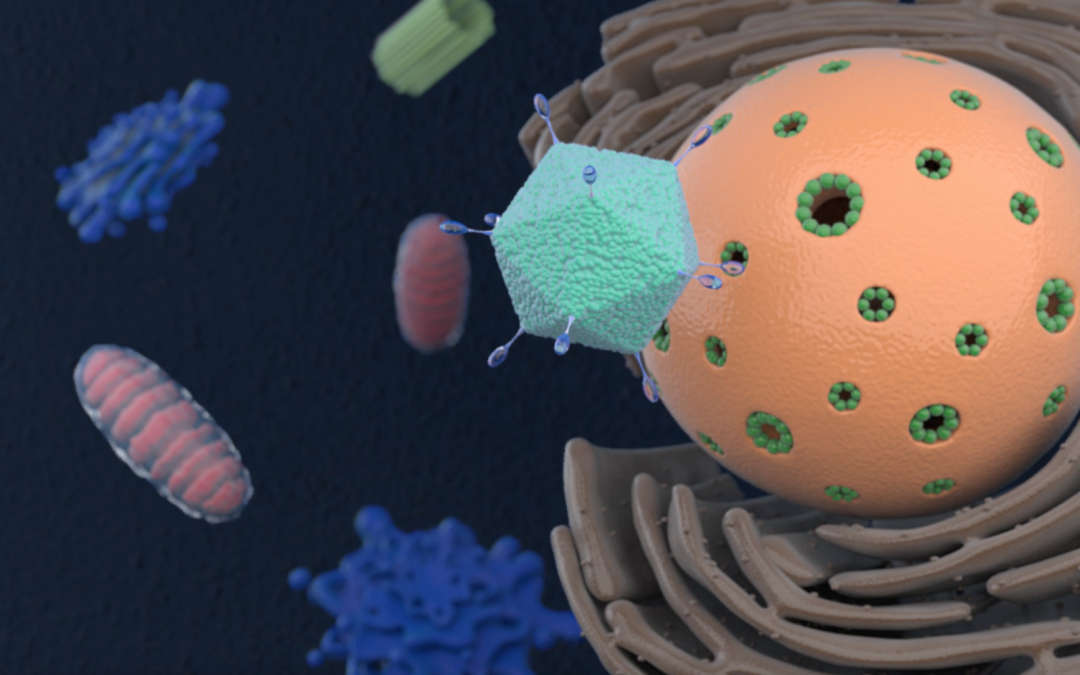Everyone of us is unique, also because of his own DNA.
It is indeed the DNA that defines our biological identity, storing all the information that our cells and body need to function.
Being the DNA the essential biological information medium, scientists have easily understood that transferring new pieces of DNA into the cells is the way to make them acquire new – potentially therapeutic – functions.
But how can we transfer a new piece of DNA from the outside to the inside of a cell?
The answer came from nature: through viruses.
INDEX:
1. VIRUSES
Viruses by their nature are very efficient at transferring their own genetic information into the host cells they infect.
This is because they need the cells of host organism to survive and reproduce.
The viral genome is usually stored in a proteinaceous part of the virus, called capsid.
Once viruses bind to the surface of the target host cell, they are then able to efficiently inject their genome (either as a DNA or as an RNA molecule) from the viral capsid inside the host cell.
The host cell will then read the viral genetic information and produce the viral proteins, which will then auto-assemble themselves to produce new viral particles.
The viral particles will finally lyse the host cells and start a new journey, looking for new hosts to be infected and reproduce themselves.
2. VIRAL VECTORS
Considering the efficiency of viruses to inject genetic information into host cells and make them produce the resulting proteins, scientists thought about using viral vector as ‘Trojan horse’, transferring therapeutic genetic material – and no more a pathogenic viral genome – into the target cells of the patient.
If we replace some the pathogenic viral genes with those of therapeutic relevance through a simple “cut and paste” process we can indeed create extremely efficient viral vectors.
Depending on which type of virus we start from, different viral vectors will be generated, inheriting some of the features of their parents, such as the maximum size of transferable genome and the type of host cells they can infect.
The idea of using viral vectors to transfer therapeutic genetic material and treat diseases is at the basis of a new branch of medicine called gene therapy.
This has already shown its power by curing genetic diseases such as ADA-SCID and by developing vaccines against multiple infectious agents, such as viruses.
3. VIRAL VECTOR-BASED VACCINES
How to you use a virus-derived vector as a vaccine against other viruses ?
Every virus has its own ‘key protein‘ with which it ‘opens’ our cells and infects us.
Imagine we want to vaccinate people against virus X: if we insert the gene coding for the key protein of virus X into a viral vector derived from virus Y and administer it to individuals, this can then enter human cells and inject inside them the information to produce the key protein of virus X.
Once produced, the key protein of virus X will be released in the body and stimulate an immune response, producing lymphocytes and antibodies specific against it.
If vaccinated people then come into contact with the real virus X, its key protein will be recognized by the antibodies present in their bodies, successfully blocking the infection.
This concept and technology are at the foundation of the first vaccine against Ebola approved at the end of 2019 and both the Johnson & Johnson’s and the AstraZeneca’s ones against COVID-19.
In this case the viral vector is derived from a specific type of adenovirus, a virus normally responsible for cold in chimps.
A weakened version of this virus, unable to replicate and harmless to the human organism, has been engineered by scientists to deliver the genetic information encoding for the spike protein, the ‘key protein‘ that SARS-CoV-2 uses to infect human cells.
Once this adenoviral-vector based vaccine is administered, our cells start to produce the SARS-CoV-2’s spike protein. The immune system then produces antibodies against the spike protein, our safeguards against a potential following infection from the real coronavirus.
4. THE IMMUNO-REVOLUTION
By delivering inside human cells the genetic information to activate an immune response against pathogenic proteins, viral vectors may represent the ultimate weapons of the so called
“Immuno-revolution“. The pharmacological revolution that exploits the immune system to fight not only infectious diseases, but also tumors.
Although effective results are clearly available, as in the case of anti COVID-19 viral vector-based vaccines, there are still many challenges to overcome.
First and foremost, the damaging emotional and cognitive biases against science and vaccines…
References:
- Viruses: Structure, Function, and Uses. Molecular Cell Biology. 4th edition.
- Viral Vectors for Gene Therapy. Pharmacology & Therapeutics
- Application of Viral Vectors for Vaccine Development with a Special Emphasis on COVID-19. Viruses
- 5 Cognitive-biases-that-explain-why-people-still-dont-vaccinate. Forbes

